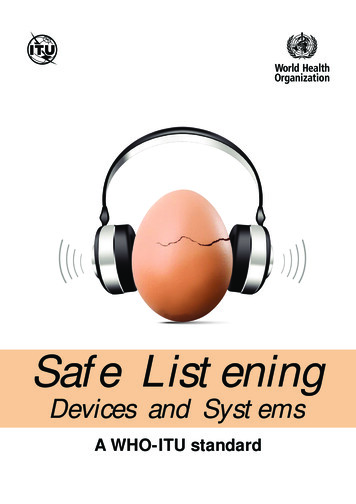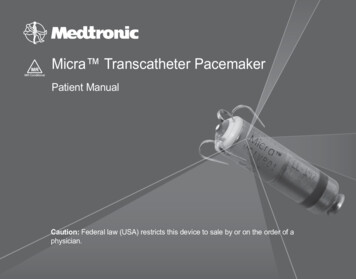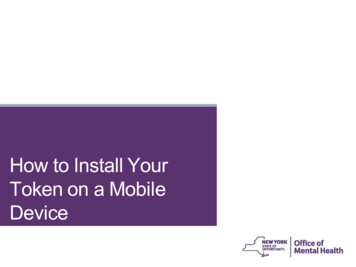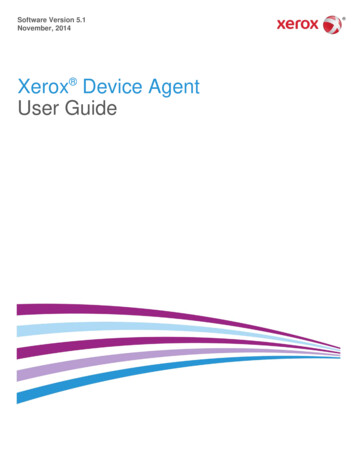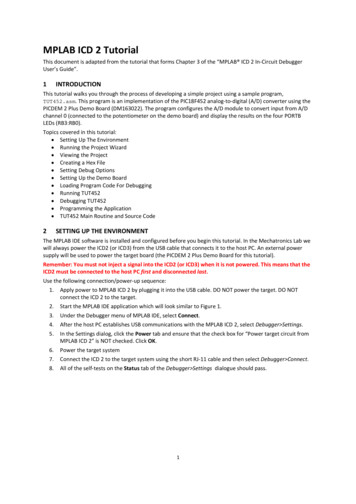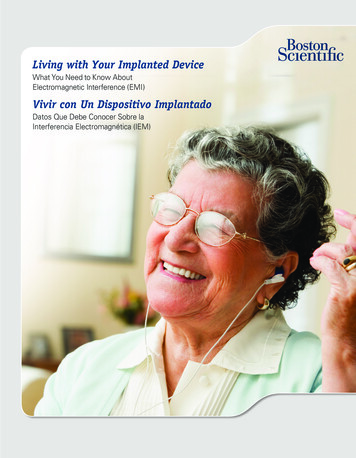
Transcription
Living with Your Implanted DeviceWhat You Need to Know AboutElectromagnetic Interference (EMI)Vivir con Un Dispositivo ImplantadoDatos Que Debe Conocer Sobre laInterferencia Electromagnética (IEM)
Your implanted heart rhythm device is designed to workproperly around most appliances and equipment.Most things you handle orwork near every day willnot cause a problem.However, people with alltypes of implanted devicesdo need to be aware thattheir device can be affectedby electromagneticinterference (EMI).What is EMI?EMI is the term used to describe the effectof an electromagnetic field on the operationof an implanted heart rhythm device.Electromagnetic fields are invisible lines offorce due to a combination of electricalfields (produced by voltage) and magneticfields (produced by current flow) that anobject emits. EMI occurs when the signalsfrom an electromagnetic field temporarilyinterfere with the intended operation of theimplanted device.Some items we use in our everyday livescreate electromagnetic fields. If you have animplanted heart device and get too close tocertain items, EMI could affect your device.How could EMI affect my device?In some cases, an implanted device maysense the electromagnetic signals producedby some objects and misinterpret them asa rapid signal coming from your heart.2
A pacemaker (including the pacemakercontained within a defibrillator) mayinterpret the signals as your heart rhythm.It may respond by withholding its pacing.Note: If you have a defibrillator, somestrong magnetic fields may cause yourdevice to make beeping tones. If you hearbeeping tones from your device, you should: A defibrillator may interpret the signals asa heart rhythm that needs therapy. Thiscould cause the device to deliver a shockthat you don’t need. In rare cases, thedevice could withhold a necessary shock. Immediately move away from the objectthat may be causing the beeping.The effects of EMI are temporary. Thecloser your implanted device is to the item,the stronger the effect. The farther away,the less effect you will experience. EMIeffects do not usually harm your device.How can a magnet affect my device?A magnet can also cause your implanteddevice to respond differently if your devicegets within 6 inches of the magnet. Yourdefibrillator will respond to a magnet basedon how your doctor has programmed yourdevice to respond. A pacemaker will respondby temporarily pacing at a different pre-setrate. Ask your doctor for more information. Call your doctor to report the beeping.Which items are safe to use?Which items shouldn’t I use?The listing in this brochure gives a broadoverview of which items are safe, whichto use precautions with, and which itemsyou should not use. This table includessome of the most common items thatcause interference. It does not includeevery item that you handle or work near.Talk to your doctor if you have more questionsabout a specific appliance, tool, medicalprocedure, or piece of equipment. Be sureto ask your doctor if you should follow anyspecial instructions not listed here. For moreinformation, you can also call Boston ScientificPatient Services at 1.866.484.3268 andvisit www.bostonscientific.com/patients.3
Note: if the item you are looking for is not listed, please contact your health care provider.TYPE OF ITEMPersonal ItemsSAFE UNDERNORMAL USE1Electric blanketsElectric toothbrushesElectric razorsHair dryersHeating padsPagersPatient alert devicesPersonal digital assistants(PDAs; unless used as cellphone; see cell phones)USEPRECAUTIONS2Cell phones Keep 6 inches from device Keep 12 inches from device iftransmits more than 3 watts Hold phone to ear on theopposite side of body fromdevice D o not carry phone in breastpocket or belt within 6 inchesof deviceKitchen, Tabletop,Household ItemsOffice, Shop, andYard EquipmentAir purifiersBlendersClothes dryersConvection ovensElectric can openersElectric ovens and stovesFood processorsGas ovens and stovesMicrowave ovensPortable space heatersVacuum cleanersWashing machinesCopy machinesElectric invisible fencesFax machinesPersonal computersArc welding equipment Keep 24 inches fromFor the following items,keep 12 inches from devic Battery-powered cordpower tools Chainsaws C orded drills and pow L awn mowers Leaf blowers Shop tools (drills,table saws, etc.) SnowblowersCordless phones Safe as long as not placeddirectly over deviceDO NOT USE3Hand-held massagers Safe as long as not placeddirectly over deviceRunning motors and alterespecially those found in Keep 24 inches from Avoid leaning over rumotors and alternatorrunning vehicle Distance required toride in a vehicle is safBody fat measuring scalesMagnetic mattresses or chairsJackhammersSafeUse precautions12These items are only considered safe from electromagneticinterference with your device when used normally inaccordance with their intended use. Check with your doctor forany additional restrictions that you may have for these items.When you are near any of these items, you should useprecautions. Check with your doctor for detailed informationbefore using these items.4
Entertainment ItemsTravel/EnvironmentDental drills and cleaning equipmentDiagnostic X-raysElectrocardiogram (ECG)Mammography(inform technician you havedevice to ensure device doesnot get compressed)UltrasoundAM/FM radiosCD/DVD playersHot tubs/whirlpool baths(with permission from yourdoctor for your medical condition)Laser tag gamesMultimedia players such as iPodsand MP3 playersRemote controls(TV, garage door, stereo,camera/video equipment)Tanning bedsTVs and VCRsVideo gamesdevicece:dlesswer toolsBingo game magnetic wands K eep 6 inches from deviceCB and police radio antennas K eep 24 inches from deviceSlot machines K eep 12 inches tfrom deviceStereo speakers K eep 12 inches from deviceDental and Medical Testsand ProceduresSecurity systems (in airports,jails, and courtrooms) Walk through securityarchways normally Tell security personnel youhave a device and showMedical Device ID card Security wand should not beheld over device more thanabout 30 seconds; ask forhand-search if possibleRadiation therapy, electrocauteryused in surgery, CT scans,TENS unit C ontact your doctor For more information,call Boston ScientificPatient Services at1.866.484.3268Theft detection systems (often instore and library entrances) Walk through theft detectionsystems at a normal pace D o not lean against or lingernear these systemsrnators,vehiclesdeviceunningrs of adrive orfeMRI scansDiathermy3Do not useTalk to your doctor. The table lists a general category ofitems only. For specific branded items, consult the originalmanufacturer for any interaction with implantable devices.5
El dispositivo que tiene implantado para el ritmo cardíaco estádiseñado para funcionar correctamente cerca de la mayoría delos artefactos y equipos.La mayoría de los elementosque manipula o que estáncerca mientras trabaja todoslos días no causarán unproblema. No obstante, laspersonas que tienen algúntipo de dispositivoimplantado deben saber queel dispositivo puede serafectado por la interferenciaelectromagnética (IEM).¿Qué es una IEM?IEM es el término usado para describir elefecto de un campo electromagnético en elfuncionamiento de un dispositivo implantadopara el ritmo cardíaco. Los camposelectromagnéticos son líneas de fuerzainvisibles generados por una combinación decampos eléctricos (producidos por el voltaje)y los campos magnéticos (producidos por elflujo de corriente) que emite un objeto. LaIEM se produce cuando las señales de uncampo electromagnético interfierentemporalmente con el funcionamientodeseado del dispositivo implantado.Algunos elementos que usamos en nuestravida diaria generan campos electromagnéticos.Si tiene un dispositivo cardíaco implantado yse acerca demasiado a determinados objetos,la IEM puede afectar al dispositivo.¿De qué manera una IEM puedeafectar al dispositivo?En algunos casos, un dispositivo implantadopuede detectar las señales electromagnéticasemitidas por algunos objetos e interpretarlasde manera errónea como una señal rápidaque viene del corazón.6
U n marcapasos (incluso el marcapasosque está dentro del desfibrilador) puedeinterpretar las señales como si fuerandel ritmo cardíaco. Puede responderreteniendo la electroestimulación cardíaca. U n desfibrilador puede interpretar lasseñales como de un ritmo cardíaco quenecesita tratamiento. Esto puede provocarque el dispositivo produzca una descargaque usted no necesita. En muy pocoscasos, el dispositivo puede retener unadescarga necesaria.Los efectos de la IEM son pasajeros. Cuantomás cerca esté el dispositivo implantado delelemento, más intenso será el efecto. Cuantomás alejado esté, menor será el efecto queexperimentará. Normalmente, la IEM noocasiona daños en el dispositivo.¿De qué manera puede afectar unimán al dispositivo?Un imán también puede ocasionar que eldispositivo implantado responda de maneradiferente si el dispositivo está a menos de6 pulgadas (15 cm) del imán. El desfibriladorresponderá a un imán según cómo elmédico haya programado el dispositivo paraque responda. Un marcapasos responderámediante una electroestimulación cardíacaprovisoria a un ritmo diferente establecidopreviamente. Para obtener más información,consulte a su médico.Nota: Si tiene un desfibrilador, algunoscampos magnéticos potentes puedenprovocar que el dispositivo emita alarmassonoras. Si las escucha, debe: A lejarse de inmediato del objeto que puedeestar haciendo que suene la alarma L lamar a su médico para informar sobre laactivación de la alarma¿Cuáles son los elementos segurosque puedo usar? ¿Cuáles son loselementos que no debería usar?El listado que aparece en este folletoproporciona una descripción general de loselementos seguros, aquellos que debenusarse con precaución y los que debenevitarse. Esta tabla incluye algunos de loselementos más comunes que provocaninterferencias. No contempla elementosespecíficos que manipula o que están cercamientras trabaja.Consulte a su médico si tiene máspreguntas sobre artefactos, herramientas,procedimientos médicos o equiposespecíficos. Asegúrese de preguntarlesi debe seguir alguna indicación especialque no figura en este material. Paraobtener más información, tambiénpuede llamar a Servicios a pacientes deBoston Scientific al 1.866.484.3268 yvisitar www.bostonscientific.com.7
Nota: Si el artículo que usted busca no aparece en la lista, por favor contacte a su proveedor de atención médica.Elementos personalesArtefactos de cocina,aparatos que se usan sobrela mesa, electrodomésticosARTEFACTOSSEGUROSCUANDO SEUSAN EN FORMANORMAL1Mantas eléctricasCepillos de dientes eléctricosAfeitadoras eléctricasSecadores de cabelloAlmohadillas térmicasLocalizadoresDispositivos de alerta parapacientesAsistentes digitales personales(PDA; salvo que se use comoteléfono celular;consulteteléfonos celulares)Purificadores de aireLicuadorasSecadoras de ropaHornos de convecciónAbrelatas eléctricosHornos y cocinas eléctricosProcesadores de alimentosHornos y cocinas de gasHornos de microondasCalefactores portátilesAspiradorasLavarropasUSO CONPRECAUCIÓN2Teléfonos celulares Mantenga a más de6 pulgadas (15 cm) deldispositivo Mantenga a más 12 pulgadas(30 cm) del dispositivo sitransmite más de 3 vatios Sostenga el teléfono en el oídoopuesto al lado donde tienecolocado el dispositivo No lleve el teléfono en elbolsillo de la camisa nien el cinturón a menosde 6 pulgadas (15 cm) deldispositivoEquipo para soldadura por arco Mantenga a más de 24 pulga(61 cm) del dispositivTeléfonos inalámbricos Son seguros siempre que nose coloquen directamentesobre el dispositivoMotores y alternadores enfuncionamiento, especialmente aqque están en los vehículos Mantenga a más de 24 pulga(61 cm) del dispositivo Evite inclinarse sobre motoresalternadores de un vehículo en Una medida de seguridad es muna distancia necesaria para cotrasladarse en un vehículoTIPOS DEELEMENTOSBalanzas que miden la grasacorporalSillas o colchones magnéticosUso seguroEquipos de copiadoCercos eléctricos invisiblesEquipos de faxComputadoras personalesMantenga los siguientes artefactode 12 pulgadas (30 cm) del dispos Herramientas eléctricas inaláque funcionan con batería Sierras de cadena Taladros y herramientas eléccon cable Cortadoras de césped Recogedores de hojas Herramientas de taller (taladrsierras fijas, etc.) Máquinas quitanievesMasajeadores manuales Son seguros siempre que nose coloquen directamentesobre el dispositivoELEMENTOS QUENO DEBE USAR3Equipos de oficina, taller y parael patioTaladros mecánicosUso con precaución12Estos elementos sólo se consideran seguros con respecto ala interferencia electromagnética con su dispositivo cuandose usan de forma normal, según el uso para el que fuerondiseñados. Consulte a su médico para conocer otrasrestricciones que puedan existir para estos elementos.Cuando esté cerca de alguno de estos elementos, apliquemedidas de precaución. Consulte a su médico para obtenerinformación detallada antes de usar estos elementos.8
aadasos a mássitivo:ámbricasctricasros,Equipos de entretenimientoViajes/Medio ambienteRadios AM/FMReproductores de CD/DVDJacuzzi/Hidromasajes(con autorización del médicopara su afección médica)Juegos con pistolas de láserReproductores multimedia, como iPody MP3Controles remotos(de TV, portón de garaje, equipo demúsica, cámaras/equipos de video)Camas solaresTelevisores y videograbadoresVideojuegosVaritas magnéticas de bingo Mantenga a más de 6 pulgadas(15 cm) del dispositivoAntenas de radio de la BandaCiudadana (CB) y de la policía Mantenga a más de 24 pulgadas(61 cm) del dispositivoMáquinas tragamonedas M antenga a más de12 pulgadas (30 cm) deldispositivoAltavoces Mantenga a más de 12 pulgadas(30 cm) del dispositivoPruebas y procedimientos médicosy odontológicosEquipos de limpieza y fresasodontológicasRadiografías de diagnósticoElectrocardiogramas (ECG)Mamografías(informe al técnico que tieneun dispositivo para asegurarsede que no lo apriete)UltrasonidoSistemas de seguridad (enaeropuertos, cárceles y salasde audiencia) Camine normalmente cuandoatraviese los arcos detectoresde seguridad Informe al personal deseguridad que tiene undispositivo y muestre latarjeta de identificación deldispositivo médico La vara de seguridad no debesostenerse sobre el dispositivopor más de 30 segundos;si fuera posible, solicite uncacheo con la manoRadioterapia, cauterizacióneléctrica que se usa en cirugía,tomografías computarizadas, unidadde electroestimulación nerviosatranscutánea (TEN) Comuníquese con su médico Para obtener más información,llame a Servicios a pacientesde Boston Scientifical1.866.484.3268Sistemas de detección de robos(por lo general, en las entradas detiendas y bibliotecas) Camine a través de lossistemas de detección derobos a un ritmo normal No se incline ni se detengacerca de estos sistemasaquellosadassyn marchamanteneronducir oEquipos de resonancia magnéticapor imágenesDiatermia3No usarHable con su médico. La tabla enumera solamente unacategoría general de elementos. Para elementos de marcasespecíficas, consulte con el fabricante original para saber sihay alguna interacción con dispositivos implantables.9
Implantable DevicesCardiac Resynchronization Therapy DevicesCardiac resynchronization therapy pacemakers (CRT-P) and defibrillators (CRT-D) are designed to treat heartfailure patients who may or may not have symptoms or who may have symptoms despite the best available drugtherapy. They are also designed to help your heart pump more effectively and meet your body’s need for bloodflow. These devices are sensitive to strong electromagnetic interference (EMI) and can be affected by certainsources of electric or magnetic fields. With all medical procedures there are risks associated. In regard to animplanted ICD, the risks include but are not limited to inappropriate shock, lead moves out of place, loss ofstimulation capability, allergic reaction, fluid underneath the skin, and infection. In rare cases device failure ordeath can occur. Be sure to talk with your doctor so that you thoroughly understand all of the risks and benefitsassociated with the implantation of this system. To obtain a copy of the device Patient Handbook for more detaileddevice safety information, go to www.bostonscientific.com, or you can request a copy by calling 1-866-484-3268or writing to Boston Scientific, 4100 Hamline Ave. N., St. Paul, MN 55112.(Rev. K)Implantable Cardioverter DefibrillatorsAn implantable cardioverter defibrillator is designed to monitor and treat heart rhythm problems, greatly reducingthe risks associated with them. These devices are sensitive to strong electromagnetic interference (EMI) and can beaffected by certain sources of electric or magnetic fields. With all medical procedures there are risks associated. Inregard to an implanted ICD, the risks include but are not limited to inappropriate shock, lead moves out of place,loss of stimulation capability, allergic reaction, fluid underneath the skin, and infection. In rare cases device failureor death can occur. Be sure to talk with your doctor so that you thoroughly understand all of the risks and benefitsassociated with the implantation of this system. To obtain a copy of the device Patient Handbook for more detaileddevice safety information, go to www.bostonscientific.com, or you can request a copy by calling 1-866-484-3268or writing to Boston Scientific, 4100 Hamline Ave. N., St. Paul, MN 55112.(Rev. K)PacemakersA pacemaker system is designed to monitor and treat your heart rhythm problems, greatly reducing the risksassociated with them. These devices are sensitive to strong electromagnetic interference (EMI) and can be affectedby certain sources of electric or magnetic fields. With all medical procedures there are risks associated. In regardan implanted pacemaker, the risks include but are not limited to inappropriate heart rate response to exercise, leadmoves out of place, loss of stimulation capability, allergic reaction, fluid underneath the skin, and infection. In rarecases device failure or death can occur. Be sure to talk with your doctor so that you thoroughly understand all ofthe risks and benefits associated with the implantation of this system. To obtain a copy of the device PatientHandbook for more detailed device safety information, go to www.bostonscientific.com, or you can request a copyby calling 1-866-484-3268 or writing to Boston Scientific, 4100 Hamline Ave. N., St. Paul, MN 55112.(Rev. K)S-ICD SystemAn implantable cardioverter defibrillator is designed to monitor and treat heart rhythm problems, greatly reducingthe risks associated with them. There are risks associated with this device including, but not limited to, allergicreactions, bleeding, death, fever, infection, kidney failure, need for surgical replacement, nerve damage, stroke andtissue damage. Electrical or magnetic fields can affect the device. In some cases, the device may not respond toirregular heartbeats or may deliver inappropriate shocks and in rare cases severe complications or device failurescan occur. Your physician should discuss all potential benefits and risks with you and describe the appropriatemedical care.Refer to the product labeling for specific indications, contraindications, warnings/precautions and adverse events.Rx only.(Rev. K)Device Quality and ReliabilityIt is Boston Scientific’s intent to provide implantable devices of high quality and reliability. However, these devicesmay exhibit malfunctions that may result in lost or compromised ability to deliver therapy. Refer to BostonScientific’s CRM product performance report on www.bostonscientific.com for more information about deviceperformance, including the types and rates of malfunctions that these devices have experienced historically. Whilehistorical data may not be predictive of future device performance, such data can provide important context forunderstanding the overall reliability of these types of products. Also, it is important that you talk with your doctorabout the risks and benefits associated with the implantation of a device.(Rev K)10
11
Rhythm Management300 Boston Scientific WayMarlborough, MA 01752-1234www.bostonscientific.comMedical Professionals:1.800.CARDIAC (227.3422)Patients and Families:1.866.484.3268 2017 Boston Scientific Corporationor its affiliates. All rights reserved.CRM-72039-ACFEB2017
Living with Your Implanted Device What You Need to Know About Electromagnetic Interference (EMI) . (IEM) Your implanted heart rhythm device is designed to work properly around most appliances and equipment. Most things you handle or work near every day will not cause a problem. However, people with all types of implanted devices do need to be .
